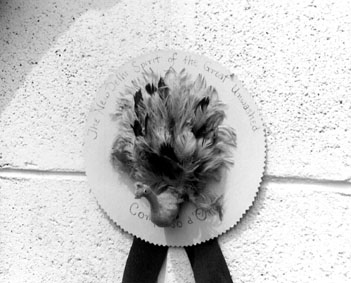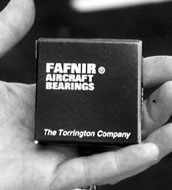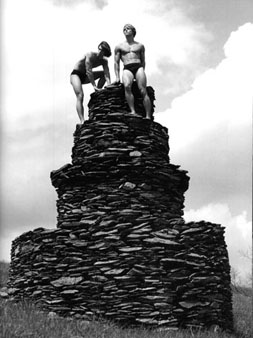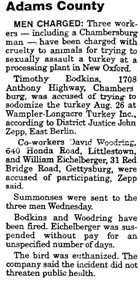Finally did fly. Butch Harbold's Sequoia 300 took
to the air the other day. Butch reports it flies quite well and
"handles like a Falco". The airplane was started in
1978, so that's about 19 years from start to finish-for an airplane
that we once hoped would be quick to build, back when everyone
thought that 'fiberglass' meant 'quick build'. When asked about
this, Sequoia President Alfred Scott replied, "Well... er...
um, I think... well... gee whiz... I didn't know that... oh,
kiss off!"
Don't let anyone ever tell you that making a fiberglass
fuselage shell mold is an easy thing. And actually there were
a few extenuating circumstances, beyond our own tardiness. There
were a number of people who 'worked' on the airplane along the
way and who created more problems than anyone should be saddled
with. It fell to Gar Williams and Charles Gutzman to fix these
things, including a 10-inch engine mount stretch to compensate
for an airplane that was unbelieveably tail-heavy due to added
gussets and the use of 1/4" steel in the tail when .063"
was called for.
|
Bad dog. The British Airways baggage handler was distressed
to see, when he removed a dog carrier from the cargo hold of
a 747 recently, that the dog had died. The resourceful man rushed
to a nearby dog pound and found a mutt that looked to be identical,
so he switched them and rushed back to the terminal.
"That's not my dog!", the lady said when seeing
it for the first time".
"How can you tell?", he asked.
"My dog's dead. I was shipping him back home to bury
him."
|
On heavily-borrowed words. Oh, I have slipped
the surly bonds of earth and danced the sky on laughter-silvered
wings... So begins one of aviation's most famous poems, High
Flight, a sonnet by a young American pilot, John Magee, who
was one of the first Americans to be killed in WW2. However,
recent research by Englishman Tony French reveals that many of
the words were borrowed, or have stunning similarities with words
in other poems published in Icarus-an anthology of the poetry
of flight, published by Macmillan in 1938. Magee wrote High
Flight in 1941.
For example, in an earlier poem New World,
G. W. M. Dunn wrote With zest we soar on laughter-silvered
wings/ From fevered ways, panic and petty deeds. From the
same poem, Dunn's hushed limbs and the lifting mind becomes
Magee's silent, lifting mind. Dunn refers to the shouting
of the air, while Magee has chased the shouting wind.
Magee's surly bonds of earth are close to
Dunn's earth fetters and the shackling sea. Magee's next-to-last
line talks of high untrespassed sanctity of space, which
bears close resemblance to the already published line Across
the unpierced sanctity of space. Magee's danced the skies echoes another poem which contains I have danced the streets
of heaven.
But the most strikingly similar line comes at the
end. Magee's most memorable line was: Put out my hand and
touched the face of God. Yet Cuthbert Hicks had already published
The Blind Man Flies. Here it is:
I am blind: I have never seen/ Sun gold nor
silver moon,/ Nor the radiant noon. They speak of the dawn and
the dusk,/ And the smile of a child,/ Of the deep red heart of
a rose,/ As of God, undefiled. But I learnt from the air today/
(On a bird's wings I flew)/ That the earth could never contain/
All of the God I knew. I felt the blue mantle of space,/ And
kissed the cloud's white hem,/ I heard the stars' majestic choir,/
And sang my praise with them. Now joy is mine through my long
night,/ I do not feel the rod,/ For I have danced the streets
of heaven,/ and touched the face of God.
But let us be kind. Magee died in a training accident
shortly afterwards. He was 19 years old. All writers begin by
imitating others and only find their own voice after years of
writing, so it's only natural that a homesick boy suddenly off
at war would try his hand at poetry by first borrowing and improving
on the work of others. And there's no way the young pilot could
ever have known what fame would attach to the poem.
Was it Edison who said, "Good designers borrow.
Great designers steal."? So it goes for words, when you
are 19 and far from home. Besides, no matter who wrote the lines,
what better words are there to end the poem but Put out my
hand and touched the face of God? |

Grand Unchampion. This is "The New Delhi Spirit of the
Great Unwashed Compaso d'Oro" awarded to The Corporate Disgrace
years ago by Dave Aronson. It features perhaps the nastiest-looking
bird you ever saw, a recycled hat ornament, if you can imagine
such a hat.
|
There's nothing like a typo in an advertisement
to blow your image. Take a look at the ad in the inside rear
cover of the July Flying for a full page ad on the Jetcruzer
500, wherein ultimate is spelled "ultilmate",
fuselage is spelled "fusealage" and pavilion is spelled
"pavillion". Oh well, it was Ms. magazine last
summer that spelled feminism incorrectly on the cover. |
| Sheesh. Remember
little Jessica Dubroff, the seven-year-old who was attempting
to set a record as the youngest person to fly across the country?
She was killed with her father and flight instructor shortly
after departure from Cheyenne, Wyoming, during stormy weather.
Now there's a foundation established in the name of Jessica which
has sued Cessna and Lycoming for negligence in the design of
the 1975 Cessna Cardinal. However, the plane was delivered 22
years ago and the recently enacted statute of repose clause of
the General Aviation Revitalization Act limits manufacturers'
liability to 18 years, so it's likely this lawsuit will go nowhere. |

Leper Colony. One of the realities of the aircraft
business for the last 10 years has been that suppliers treat
you like a leper when they hear the word 'aircraft'. Indeed,
many companies simply will not sell parts to anyone in the aircraft
business, but within the aircraft business and for aircraft parts,
that's never been a problem. However, the other day we placed
an order for some Fafnir bearings. The bearings are for aircraft,
indeed on the package it clearly says "AIRCRAFT BEARINGS"
in large, bold type. However, before we could buy them, we had
to assure our local bearing supplier that the parts were not
going into an aircraft before they would sell them to us. What
other use Sequoia Aircraft would have for 50 aircraft bearings
is beyond us, but that's the way the world turns these days.
|
Udderly ridiculous tale. Nobody believed the crew of the Japanese
trawler which sank in the Sea of Japan. Their story seemed utterly
preposterous -- that a cow had fallen on the ship out of the clear
blue sky, punched a hole in the hull of the ship, and that's what caused the ship to sink. Yeah, right, and what had you been
drinking at the time?
However, a couple of weeks later, confirmation came out of
Russia that the crew of a military cargo jet had stolen a cow
they found on a Siberian airfield and loaded it on for the flight
home. While cruising at 30,000 feet, the cow became terrified
and ran amok, so the crew lowered the cargo ramp, and it jumped
out.
|
A Falco took the Grand Champion Award (Plans Built)
once again at the Popular Flying Association Rally at Cranfield
and also the Pilot Magazine Trophy for Concours d'Elegance.
It was G-OCAD, built by Clive Garrard, Gordon Blunt and David
Nowill from Leicestershire. Five and a half years abuilding,
first flew 21 December '96. Truly faultless, perhaps even better
than Stuart Gane's (which has been rebuilt and awaits its second
first flight).
Pilot wasn't in any way involved in the
judging, but I was rubbernecking incognito when one of the Falco's
builders caught me sighting along the wing. "You bugger!
I know what you're up to. You're looking for the ribs!"
he challenged.
He was right, but they were only just visible if
you really looked hard. The most commonly heard remark at the
PFA Rally prior to judging was, "If you want to see the
champion homebuilt, don't bother to look any further than that
Falco." It was the talk of the show, and rightly so in my
estimation, though as a Frati-freak, I'd have to admit to a certain
bias.
Mike Jerram
|
| Carla Bielli reports
that Richard Thompson was prescient in his 'Leonardo da Frati'
cartoon in Air & Space. In May, Stelio Frati was awarded
the 1997 Leonardo da Vinci award by the Italian Association of
Industrial Engineers to recognize Mr. Frati's work as an aircraft
designer. |

My grandfather built a rather famous house on the
top of a mountain near Charlottesville, Virginia, and it's now
jointly owned by a hundred or so decendents. This spring we were
approached by a fashion designer we'd never heard of who wanted
to rent the place for a week to shoot his fall advertising campaign.
It was all great fun, they came and went. Then in July, the designer
was shot in Miami, and suddenly everyone in the world knows him.
Hard way to get name recognition, but watch the current magazines
for Versace and Versus labels.
Scoti
|
Turbulent teats. You would expect that female swimmers, with
their smoothly curved profiles would be able to slice through
the water more efficiently than their male counterparts, and
to an extent, they can. However, these curves can present some
hydrodynamic problems as well. A woman's breasts create turbulence
in their wake, and this wastes energy and slows the swimmer down.
However, you'll be happy to know that Mizuno, Japan's largest
manufacture of sporting goods has come up with a solution that's
borrowed from aviation. Mizuno has developed a bathing suit with
vortex generators on the down-stream side of the bustline, where
the laminar flow becomes unstuck. The tiny vortex generators
cause the flow to be held tightly to the surface. In addition,
the bathing suits are treated with a water repellant to further
reduce the swimsuit's friction. Mizuno calculates that these
measures produce 9.5% less drag than a conventional swimsuit.
|
 |
| The end of Tony's
Falco. Tony Bingelis's Falco recently came to a splintery end
in a landing accident at the Watsonville, California, airport.
The Falco had just been completely gone over with a new panel,
autopilot and engine. And the IO-320 has been boosted up so that
it produced 198 hp on a dyno. On short final, Courtney Graham,
the new owner, advanced the throttle and the engine stumbled
as if flooded and put out less power, not more. Had they been
over the runway, Courtney says, it would simply have been a hard
landing, but they were just short of the runway end. They settled
into the localizer antenna, which sliced the plane to pieces.
Courtney and his passenger stepped out of the plane with neither
a scratch nor a bruise. |
Congratulations to Jonas Dovydenas for Second Prize
in the General category of the 1997 Aviation Week and Space
Technology Photo Contest.
The winning photo is from the tail of his Falco
while over Lake Powell, and it is very similar to the one printed
in "The Five Hundred Dollar Burger" (June 1997 FBL).
The awards will be announced in the December 22/29, 1997, issue
of Aviation Week. |
It's a small world. No one was more surprised to see the Versace
ads on the pages of the September Falco Builders Letter than
Andrea Tremolada of Milan, Italy, where he is a Falco builder
at night and Versace advertising manager by day, in charge of
an $88 million advertising budget.
Andrea's Falco is taking shape quickly (he has a few helpers),
and he also also owns an SF.260 and a Stampe. He's just sold
his production Falco which will be replaced with the Falco he's
building now.
|
U.S. Health policy. Legislation introduced by Democrat
Rep. Fortney "Pete" Stark of California (H.R. 2784)
would amend the Social Security Act to limit the ability of physicians
to demand more money through private contracts during periods
in which the patient is in an exposed condition.
As the bill puts it, "To produce equality
in the negotiation of private contracts, the Secretary of Health
and Human Services shall issue regulations prohibiting the discussion
or signing of private contracts at any time
(a) the patient is buck naked and the doctor is
fully clothed;
(b) the patient is wearing on of those short, flimsy little hospital
gowns that don't close in the back;
(c) during any sigmoidoscopic or proctoscopic examination of
the gastrointestinal tract or a digital rectal examination of
the prostate;
(d) during any testicular examination;
(e) at any time the patient's legs are in a stirrup device;
(f) at any time the patient is using a bedpan or in the middle
of the administration of an enema;
(g) at any time one has been asked to give a urine or stool sample;
and
(h) at any other time that the Secretary determines that a normal
human being would find it awkward to negotiate a contract."
|
 
|
![]()